Definition, Formula, Equation, Solved Example Problems - Rotational Dynamics | 11th Physics : UNIT 5 : Motion of System of Particles and Rigid Bodies
Chapter: 11th Physics : UNIT 5 : Motion of System of Particles and Rigid Bodies
Rotational Dynamics
ROTATIONAL DYNAMICS
The
relations among torque, angular acceleration, angular momentum, angular
velocity and moment of inertia were seen in previous Section. In continuation to
that, in this section, we will learn the relations among the other dynamical
quantities like work, kinetic energy in rotational motion of rigid bodies.
Finally a comparison between the translational and rotational quantities is
made with a tabulation.
Effect
of Torque on Rigid
Bodies
A
rigid body which has non zero external torque ( τ) about the
axis of rotation would have an angular acceleration ( α) about that axis. The scalar
relation between the torque and angular acceleration is,
τ = I α (5.48)

where,
I is the moment of inertia of the rigid body. The torque in rotational motion
is equivalent to the force in linear motion.
Conservation of Angular Momentum
When
no external torque acts on the body, the net angular momentum of a rotating
rigid body remains constant. This is known as law of conservation of angular
momentum.

As
the angular momentum is L = I ω, the conservation of angular
momentum could further be written for initial and final situations as,
Iiωi
= Ifωf (or) Iω = constant (5.50)

The
above equations say that if I increases ω will decrease and vice-versa to keep
the angular momentum constant.
There
are several situations where the principle of conservation of angular momentum
is applicable. One striking example is an ice dancer as shown in Figure 5.27.
The dancer spins slowly when the hands are stretched out and spins faster when
the hands are brought close to the body. Stretching of hands away from body
increases moment of inertia, thus the angular velocity decreases resulting in
slower spin. When the hands are brought close to the body, the moment of
inertia decreases, and
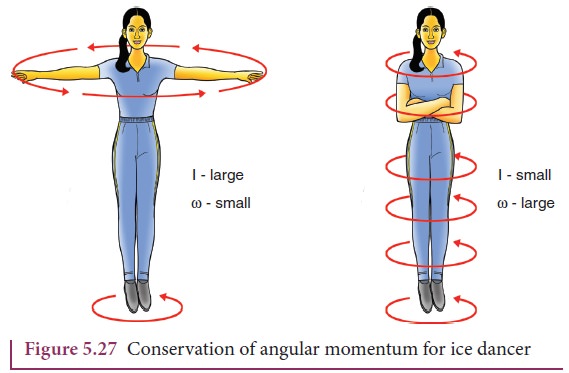
A
diver while in air as in Figure 5.28 curls the body close to decrease the
moment of inertia, which in turn helps to increase the number of somersaults in
air.
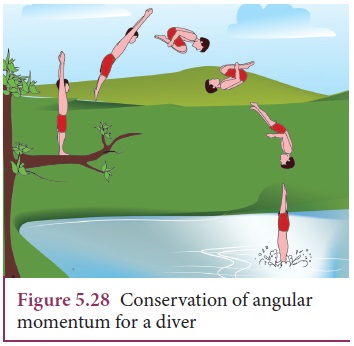
Work done by Torque
Let
us consider a rigid body rotating about a fixed axis. Figure 5.29 shows a point
P on the body rotating about an axis perpendicular to the plane of the page. A
tangential force F is applied on the body.
It
produces a small displacement ds on the body. The work done (dw) by the force
is,
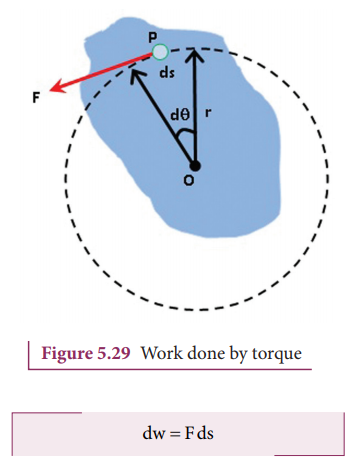
dw = Fds
As
the distance ds, the angle of rotation dθ and radius r are related by the
expression,
ds = rdθ
The
expression for work done now becomes,
dw = F ds; dw = F r dθ
The
term (Fr) is the torque τ produced by the force on the body.
dw = τdθ (5.51)

This
expression gives the work done by the external torque τ, which acts on the body
rotating about a fixed axis through an angle dθ.
The
corresponding expression for work done in translational motion is,
dw = Fds

Kinetic Energy in Rotation
Let
us consider a rigid body rotating with angular velocity ω about an axis as
shown in Figure 5.30. Every particle of the body will have the same angular
velocity ω and different tangential velocities v based on its positions from
the axis of rotation.

Let
us choose a particle of mass mi situated at distance ri
from the axis of rotation. It has a tangential velocity vi given by
the relation, vi = ri ω. The kinetic energy
KEi of the particle is,

Writing
the expression with the angular velocity,

For
the kinetic energy of the whole body, which is made up of large number of such
particles, the equation is written with summation as,

where,
the term Σmi ri2
is the moment of inertia I of the whole body. I = Σmi ri2
Hence,
the expression for KE of the rigid body in rotational motion is,

This
is analogous to the expression for kinetic energy in translational motion.

Relation between rotational kinetic energy and angular momentum
Let
a rigid body of moment of inertia I rotate with angular velocity ω.
The
angular momentum of a rigid body is, L = I ω
The
rotational kinetic energy of the rigid body is, KE = 1/2 Iω2
By
multiplying the numerator and denominator of the above equation with I, we get
a relation between L and KE as,
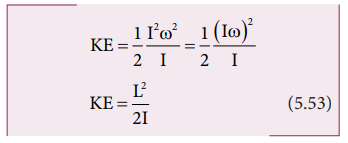
Power
Delivered by Torque
Power delivered is the work done per unit time. If we differentiate the expression for


Comparison of Translational and Rotational Quantities
Many quantities in rotational motion
have expressions similar to that of translational motion. The rotational terms
are compared with the translational equivalents in Table 5.4.
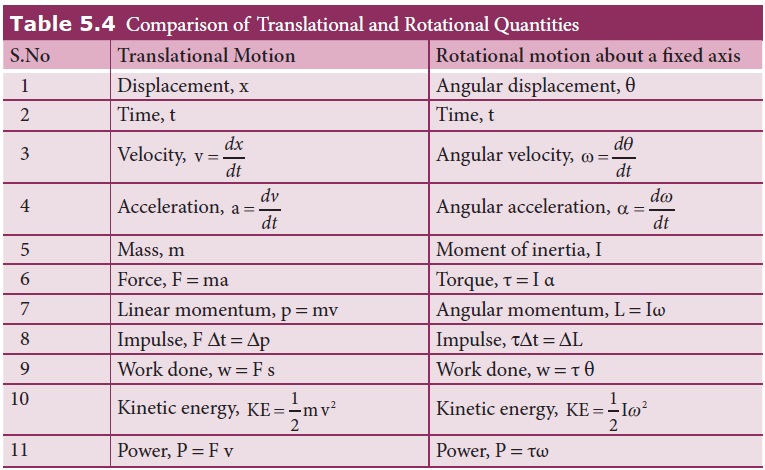
Solved Example Problems for Effect of Torque on Rigid Bodies
Example 5.18
A disc of mass 500 g and radius 10 cm can freely rotate about a fixed axis as shown in Figure A. light and inextensible string is wound several turns around it and 100 g body is suspended at its free end. Find the acceleration of this mass. [Given: The string makes the disc to rotate and does not slip over it. g = 10 m s-2.]
Solution

Let the mass of the disc be m1 and its radius R. The mass of the suspended body is m2.

As the light inextensible string is wound around the disc several times it makes the disc rotate without slipping over it. The translational acceleration of m2 and tangential acceleration of m1 will be the same. Let us draw the free body diagram (FBD) of m1 and m2 separately.
FBD of the disc:

Its gravitational force (m1g) acts downward and normal force N exerted by the fixed support at the center acts upward. The tension T acts downward at the edge. The gravitational force (m1g) and the normal force (N) cancel each other. m1g = N
The tension T produces a torque (R T), which produces a rotational motion in the disc with angular acceleration, (α=a/R)
Here, a is the linear acceleration of a point at the edge of the disc. If the moment of inertia of the disc is I and its radius of gyration is K, then
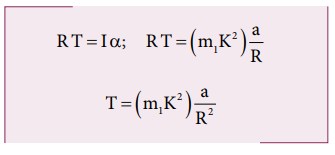
FBD of the body:
Its gravitational force (m2g) acts downward and the tension T acts upward. As (T < m2g), there is a resultant force (m2a) acting on it downward.
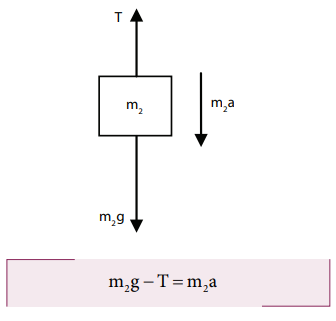
Substituting for T from the equation for disc,
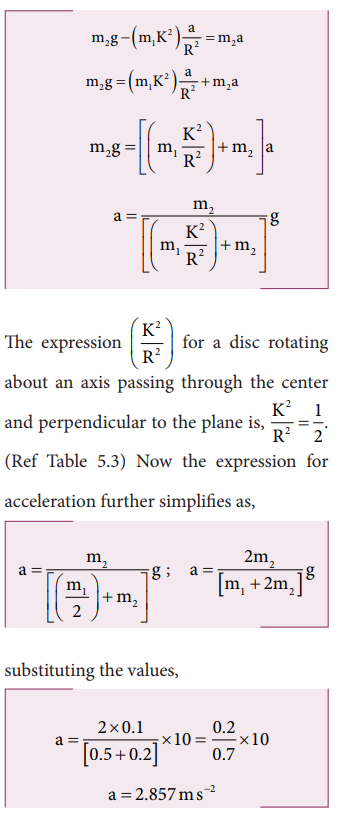
Solved Example Problems for Conservation of Angular Momentum
Example 5.19
A jester in a circus is standing with his arms extended on a turn table rotating with angular velocity ω. He brings his arms closer to his body so that his moment of inertia is reduced to one third of the original value. Find his new angular velocity. [Given: There is no external torque on the turn table in the given situation.]
Solution
Let the moment of inertia of the jester with his arms extended be I. As there is no external torque acting on the jester and the turn table, his total angular momentum is conserved. We can write the equation,
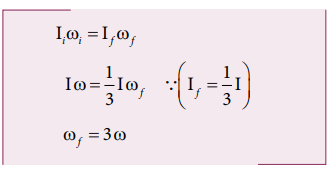
The above result tells that the final angular velocity is three times that of initial angular velocity.
Solved Example Problems for Kinetic Energy in Rotation
Example 5.20
Find the rotational kinetic energy of a ring of mass 9 kg and radius 3 m rotating with 240 rpm about an axis passing through its center and perpendicular to its plane. (rpm is a unit of speen of rotation which means revolutions per minute)
Solution

Related Topics